| To
Part Two
To Part One
The pavilion at the visitor's center is a large structure with
open sides, exposed rafters, and benches all around. On my stomp
up the beach from the camp, I picked up a two-fathom length of
5/16 twisted nylon line that had been lying in the sand. At the
pavilion, I used the line to suspend my sleeping bag and bivysack
from the rafters while I draped my rain gear, hat, long-sleeved
shirt, and any other items I had in my possession from any exposed
bolt or corner until the space looked like the aftermath of an
explosion inside a sporting goods store. I had considered removing
my pants and hanging them up as well, but decided the flora and
fauna of Cape Lookout, NC, didn't need to be exposed to the vision
of my expanse of pasty white flesh as I pranced about in my quick-dry
undies.
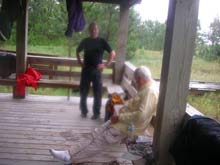 |
Mike and the author at the pavilion |
It didn't take very long at all before I was thoroughly bored
with watching my clothes dry. It was still blowing like stink
and raining puppies, so I figured my gear would be safe enough
for me to make a quick run back to camp and grab some food. When
I showed up at our motley collection of wind-blown tents, I found
everyone very concerned with my state of mind. “Are you
OK? You're not mad or anything?” “No no no, I just
know that anyone can suffer through one wet night, but two wet
nights in a row is hell on earth. I'm just doing my best to dry
my stuff.” “OK, and I have room in my tent if you
need it tonight.” Once everyone had been reassured, I snagged
enough grub to last the day – I had no illusions that my
gear was going to dry any time soon – and headed back. There
was no use in changing into dry clothes or even grabbing a book
to help pass the time as they'd just get soaked on my walk back
to the pavilion. I did, however, put on a poncho to keep from
getting any wetter than I was already.
At the pavilion, there was nothing to do but try to wring water
out of my gear and have a staring contest with a bird, bright
red cardinal that had come in looking for a handout. He stared
me down twice before I gave in and tossed him a sliver of almond
– which be promptly lost to some blue/black colored bird
that was both thinner and larger than a standard robin (I had
a lot of time for observation.) I tried to win back the almond
for its rightful owner by shouting at the interloper, but that
just scared all the birds away and I was left with just my dripping
clothes, the howling wind, and the pounding rain. Finally, after
an interminable minute or two, I remembered reading a sea story
where the captain of the ship purchased barrels of short pieces
of rope before leaving on a long sea voyage. Anytime he thought
the men were too idle, he'd set them to picking apart the bits
of rope into bits of yarn – supposedly the origin of the
term 'yarning' or 'telling yarns' as the men would chatter while
they did the busywork. (Upon returning to shore, the captain would
then take the barrels of what used-to-be-rope-but-is-now-yarn
and sell then to rope makers, completing the cycle of ropelife.)
| The author yarning |
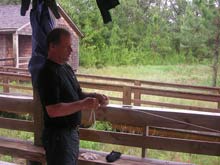 |
Eager for any form of stimulus other than wind or rain, I rearranged
my gear and began 'yarning' with my two-fathom piece of rope.
While this was clearly busywork with no practical purpose, I did
learn that in 3-strand twisted-nylon rope, each strand is made
from two twisted pairs of strings, and each string made of two
pairs of twisted 'yarns.' Four yarns to a string, four strings
to a strand, three strands to a rope makes 24 yarns per rope.
Additionally, all that twisting requires each yarn to be about
four fathoms long to get a two-fathom rope. That's a lot of twisting
– or, in my case, a lot of untwisting, so much so that by
the time I was done, the rain had stopped, the winds had dropped,
the sun had come out, and my gear had dried. Huzzah to that skinty
old sea captain, Huzzah!
Back at camp, we had to figure out what we were going to do
since we had lost the entire day of Wednesday. As luck would have
it, Paul had the foresight to design in a day that would have
been used as a messabout, where we could take turns sailing each
other's boats. That didn't solve all our problems, however, as
the wind was still expected to be coming from the northeast, right
in our teeth, blowing strongly in the morning and mitigating through
the afternoon. Just to keep us hopeful, the meteorologists at
NOAA always included the teaser “possibly shifting to the
east in the afternoon” which would have given us the fabled
'Soldier's wind' and allowed us to sail on a broad reach. With
nearly 20 sailing miles direct to windward from Cape Lookout to
our previous camp at the abandoned gun club, we'd have to do some
fine sailing, indeed.
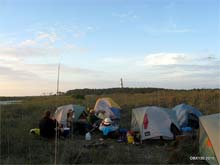 |
Blue sky over Cape Lookout |
As nasty as Tuesday night had been, Wednesday afternoon and
evening had me feeling chipper again – chipper but still
suspicious of the fickle weather of the Outer Banks. We passed
the end of Wednesday exploring the island, crossing over to the
Atlantic side and gathering firewood for the bacchanal that evening
(any evening spent while sailing and camping deserves to be celebrated
with a bacchanal.) Late in the day, we were joined by George Broadlick
as he sailed his Bolger-designed Sweet Pea into our little bay.
The double-ended Sweet Pea was a little tender for the conditions
of the day, especially since George had eschewed the as-designed
59 sqft Leg-o-Mutton for an ~80 sqft Leg-o-Mutton that had been
pirated off one of his other 11 boats, an Iain Oughtred design.
He had sailed her in from Harker’s Island with three reefs
tucked into her sail, and looking exhausted, admitted, “I
wish I had four reefs to put in it.” Through George, we
learned what had happened to Jester the Nordic 16 with our intrepid
Canadian, Pete. As Jester had taken to the seas without benefit
of a chart, GPS, or radio, Pete had spent the previous night anchored
out and had motored his way to Harker’s, where as he arranged
passage to Cedar Island for his truck and trailer, he was heard
to resolved to return next year, better equipped and more prepared.
Night fell, the fire roared, and the sounds of story telling blew
across the windswept sea grass. Eventually, the laughter died
and we shuffled off to our respective sleeping areas, with one
eye still on the clouds, I finagled some space in Sean’s
tent.
| George Broadlick arrives with three reefs |
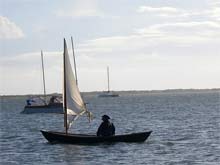 |
Thursday’s dawn came with clear skies, moderate seas, and
winds in the low teens. We shipped Sean with us in the Laguna
again, while Paul and Stuart - the other two free-boaters –
found berths in other boats. The tide was scheduled to change
from high to low at 7:10 am, and the resulting outrush of water
through the Barden Inlet (pinchy point between the strand of Cape
Lookout and Shackleford Island) might slow us to a stop if the
wind was against us, as predicted. The armada left the shore at
roughly 6:30 am, the Laguna sliding easily across the chop. We
were doing so well, in fact, we decided to pull over at the park
at Harker’s Island and use the facilities. It was only 8:30
and the park’s visitor center didn’t open until 9:00,
but they had been so impressed watching our approach, the rangers
opened the doors early. You just can’t beat southern hospitality.
We dilly-dallied so long at the ranger station that most of
the fleet passed us by. The crew of Laguna Dos: Blue Laguna might
have been getting a little cocky by this stage of the OBX130,
maybe just a little too sure of our much vaunted speed and shallow
water capabilities. We set out, making ‘short-boards’
to the east-northeast and ‘long-boards’ to the north-northwest,
but the winds decided to stick it to us once again, only this
time they dropped to less than 5 mph. The Laguna was designed
for the brutal winds of the Laguna Madre in the Texas Gulf, not
for farting along in light winds and capricious breezes. Ember’s
Watch, the remaining Mike’s Boat, captained by Bill, the
senior Moffett, crewed by the privateer, Stuart, and live ballasted
by Chuck ‘the Duck’ Leinweber soon disappeared from
sight over the horizon. Still, even with our extended potty stop
and puffy little baby breezes, we seemed to be in second place.
Then, as we approached the abandoned gun club at the pace of an
arthritic snail, we saw the strangest thing: Ember’s Watch
hard aground on the same shallows that had plagued them back when
they had first run afoul of the sands back on Monday. The slow-to-learn
crew seemed to come alive at the sight of our lily-white sails
bearing down on them. All the sudden, what had been a rather dull
day at sea took on an urgency usually associated with the America’s
Cup. We were still nearly a mile out when Ember’s Watch
suddenly broke free of the shoals and started moving towards the
docks. Both Sean and I noticed something funny about how the boat
was moving – she was making headway, but her mainsail seemed
to be luffing. We were intersecting at and obtuse angle, they
having tacked to the docks from a more northerly position, so
as we approached the finish line, our boats were getting closer
together as well. It didn’t take long for their retched
trickery to reveal itself: they were running to the docks under
paddle power while the pure and stalwart Hearts of Oak in the
Laguna were sailing in, as sailing men do. Then we ran aground
and they gained the docks ahead of us. In disgust, I broke out
the sweeps and powered us in as well.
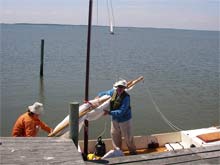 |
Bill and crew secure Ember's Watch at the Gun Club docks as Blue Laguna rows in. |
For the rest of the afternoon, the remainder of the convoy came
in, we’d been followed closely by MacDevitt and Paul in
the Windrider 17, Tony Day in the lovely Princess 22, Susan G,
and finally, incredibly, George in his Bolger Sweet Pea. I was
very impressed with his sailing ability, as the Sweet Pea was
the least weatherly craft in our fleet, and he had his trailer
back on Harker’s Island, which he had passed ten miles ago.
Tenacity is a trait I do not possess, and I am always in awe when
I encounter it.
The evening at the abandoned gun club passed like it was wrapped
in enchantment. As the sun set, it cast a golden glow over the
fleet as it rested at anchor. Black skimmers – birds unknown
to me before this trip – silently slipped over the surface
of the water, dragging their beaks through the ripples as they
flew along, hunting unwary fish just under the line where the
sea meets the air. On land, fireflies appeared in the field around
the ruins of the club, dancing like living stars among the grasses
and scrub. Even the deerflies had quit the field and with the
exception of the sparkling fireflies, the air was remarkably free
of bugs. Later, well after dark, flounder fishermen passed by
the shore, two men with gigs on the bow while a compatriot operated
the lights and motor – another phenomena I had never witnessed
before. As all good things come to an end, so did this enchanted
evening. As I made up my bed in the stern of the Laguna, the wind
began to rise, driving the seas before it, and I spent another
sleepless night, tied to the docks of with the wind shrieking
in the rigging and the waves pounding the hull.
| Sunset at the Gun Club - Sweetpea and Princess 22 |
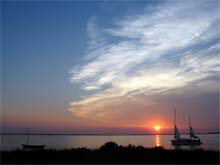 |
Friday dawned in an ugly light, the winds were blowing in the
high teens directly from our desired direction of travel, frothing
the waters were a field of white horses. There was nothing for
it, and I was in the worst position a sailor could be: I had a
schedule to keep, a plane to catch, and a list of appointments
to meet. The conditions were untenable for leaving shore, and
I fretted as the wind continued to blow foam from the tops of
the waves. At what level of the Beaufort Scale do streaks appear
on the surface? We spent the morning hiding in the ruins of the
gun club’s porch, perched on cinder blocks and scowling
at the seas and sky. Tony must have been fretting even more than
I, as he upped sail and took off in his Princess 22 before anyone
else dared set forth on the water. We all watched in amazement
as he fell off before the wind and was slowly blown across the
sound. We could just barely make out his twin sails against the
gray bulk of the mainland as he fought his way back to windward.
By the time he had reached a spot directly across from us, the
winds seemed to start calming and an unspoken, unconscious, decision
was made for everyone to take to the sea.
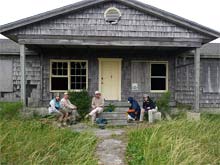 |
Hiding in the ruins of the gun club. |
Sean was shifted to the Waverider 17, Paul to his father’s
Mike’s Boat, we took on Stuart as crew on the Laguna, and
everyone kicked off the beach with anticipation of an interesting
day at sea. It had been four days since we had sailed in these
waters, and I had already forgotten where the shallows were, not
that it mattered as we missed them all, this time around. We were
still beating to windward, still shipping spray (but no water
over the bow or sides,) and still pinching the wind to keep as
northeasterly course as possible, but something was different
about today: We were running for home. Everyone had launched with
reefed sails, and as long as the sails were reefed, the Mike’s
Boat kept pace with us, actually keeping to windward to us and
perhaps slowly gaining. When the wind began to mitigate and drop
into the middle teens, the Mike’s Boat shook out the reefs
from her 96 sqft mainsail and we shook out our reefs, going from
~ 75 sqft in total area to ~150 sqft. The Laguna really started
strutting her stuff and she took off, skittering across the wavetops
and walking away from everyone. We rounded the headland that guarded
the entrance to the run to the campground at Cedar Island, our
ridiculously shallow draft once again making up for the pitiful
quality of our charts. We pulled into the campgrounds, had our
boat loaded on the trailer, and stowed our gear before any other
sails peeked around the headlands.
| With reefs out, Blue Laguna runs for home |
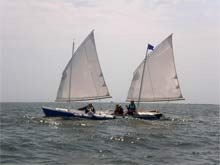 |
Our final evening of the 2010 OBX130 was spent in good company,
surrounded by people with whom I had suffered and celebrated through
a common experience. I have chosen sailing as a venue for me to
meet new people, see more of America, and learn more about both
the history of our country and also the forces that helped shape
it. The OBX130 was a fantastic and fulfilling event in every respect.
The End
Andrew Linn
*****
More articles about the OBX130:
I
can’t believe I ate half that bag of … !
By Sean Moffitt
The
OBX By Paul Moffitt
Article
in Reports by Paul
The OBX 130 Website

*****
|

